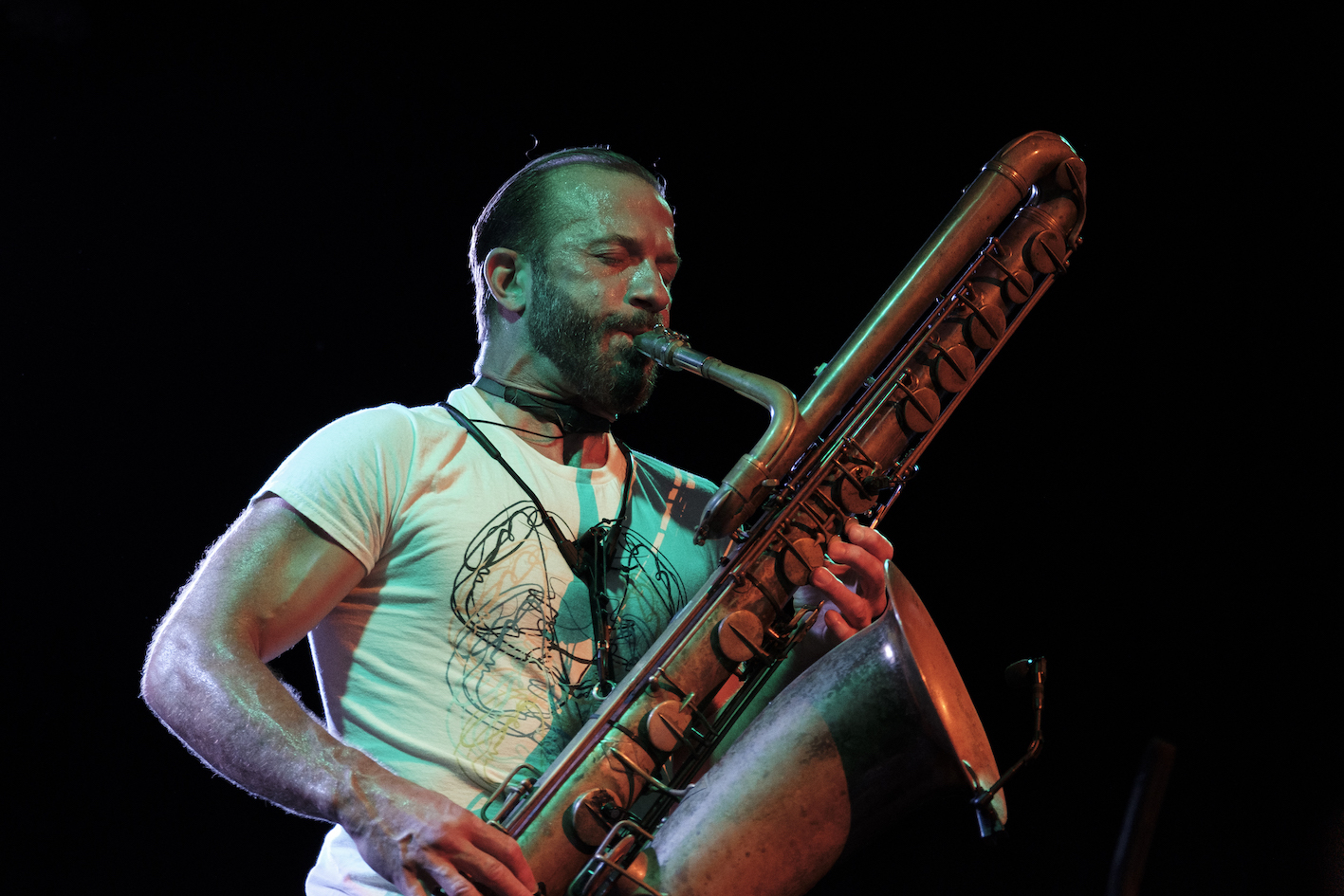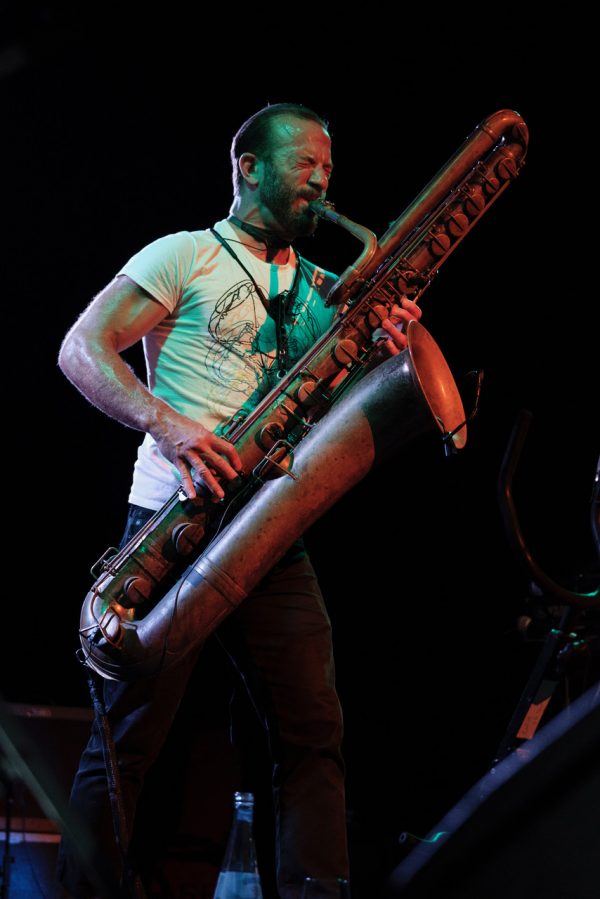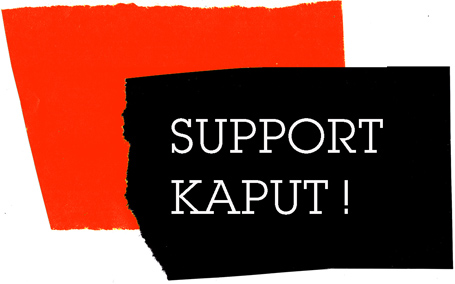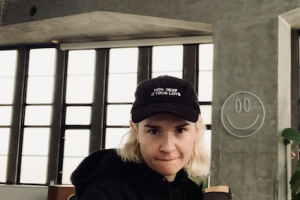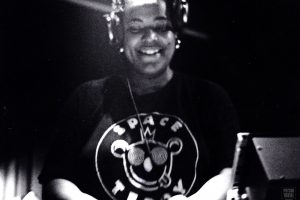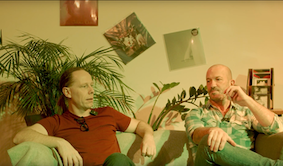Colin Stetson: “It starts and you’re there, and every muscle in your body is engaged and every aspect of your mind is fully lit up”
When you see Colin Stetson wrestling with his 112 year old bass saxophone, carving sounds out of his lungs that wander along the line between tone and noise, it is a very impressive and beautiful and frightening picture.
The musician and composer of American descent (who is now a Canadian) has been creating a very unique sonic universe by multi-microphoning his instrument as well as his body and using different musical techniques like circular breathing and multiphonics. Besides his works as a solo-artist, ensemble- and band-member Colin Stetson has also become an acknowledged film composer.
I met Colin Stetson at the Prequel to the covid-postponed Monheim Triennale, where 18 musicians from all over the world played 20-minute miniature concerts solo and in different group constellations. Over the course of three days. On a boat. .
Colin, how do you feel about the concept of the Prequel?
Colin Stetson: I love it! It’s a rare thing this programming, I can’t really remember the last time I did something like this beyond when I was very young. I think for a number of reasons it feels very fresh, spontaneous. It feels very youthful in what it’s bringing out of everybody.
You knew some of these musicians before you came to Monheim, right?
Yeah. It’s a combination of people that you’ve known forever and people that you’ve known of and some that you don’t know at all. In that sense it´s like a summer camp with like-minded individuals and like-lived individuals. It’s certainly not unique in the history of things, but it is very rare and especially right now because I can’t remember the last time we did something that was quite like this.
Listening to so much music over the course of three days, for me it’s also very refreshing to have these short 20 minute sets because you stay concentrated to what’s happening and it gives you the possibility as a listener of being able to follow through very closely.
Exactly. There is something to these epic several day jazz festivals – where they try to pack in as much as they possibly can and people are running from set to set – which I’ve never enjoyed. Keeping something stripped down enough so that it is really digestible and people are not incentivized to run from one show to find another show – I mean, I despise that programming.
On top: it’s all on one boat!
This is all on a boat. Yeah!
You’re trapped in the music.
Yeah, perfect.
Some of your solo compositions are 1 1/2 minutes long and feel like fragments. Others are these 30 minute long journeys. But for me both types feel very much connected and related. What role does time play in your music and what’s your perception of time when you’re playing and composing?
There’s the level of time in the narrative, kind of imbued into the story that I’m telling and that stitched through all the different conversations. For example, all of my solo records and several other records that I’ve done as well are all temporarily and narratively tied to the same world, the same concept of place and character.
There’s that level of time. So your reference to there being things that connect one piece to another: that’s intentional.
I specifically use fragments that I use from one song to the next. Some might be a minute or two minutes long, just something that is kind of an afterthought or almost like just a glimmer of something that is not quite yet come and then the next time it happens on another record perhaps or later on on that record. When an idea that’s just to seed there gets an opportunity to fully be fleshed out and inhabit the world. So there’s an interconnectness of all of them.
I suppose temporarily there’s this narrative level where there’s more of a filling in of memory between albums.
Like my last solo record, temporally speaking, happens somewhere before the first record, like way before the first record.
Constantly when I’m writing music, I’m thinking about what it is that it’s telling. What aspect of the story is it telling? Is this something that’s forming the world that I’ve already explored or is it something that is coming after something that I haven’t conceived of yet? So that to me is fascinating and fun and challenging and I love the world-building aspect of that.
Greg Fox and I talk a lot about the idea of maximalism and we kind of redefine the term. Simply put: creating a supersaturation of time-space that attacks the senses in a way where it forces a listener to be absolutely present and to shut down that aspect of our brains which is seeing into the future or the past, constantly contemplating future and past. Future past future past… at the detriment of the present moment.
So the idea behind everything that I do is to try to create a new a kind of unavoidable now.
A necessity of the moment.
Once that is attained then the idea of many of the pieces is to entrap that and to alter that perception of time. If we can slow things down, if we can make it feel as though we’ve been there for eons … can we take that present moment and freeze it in some sense?
And how do you do that? How do I do that? We have psychological triggers. There are things that trigger our anxieties that can put you initially on edge.
Have you ever been in a in a very quiet forest when it’s getting dark? It’s very dark and you’re alone and you start hearing sounds and because of the darkening of the light you start growing instinctual anxiety. Those sounds start to turn. They start to peak your imagination.
And that might be soothing or frightening.
Yeah, so ultimately the experience can end up being something that’s scary. It can end up being something that is quite transcendent. It can end up being a number of things. There’s something baseline ancestral about our reaction to certain kinds of sounds, certain immediacies and so I try to use that as a foot in the doorway of pulling in a level of attention and then once you have that then it can be something where time really becomes relative.
For me the short pieces don’t feel shorter than the long pieces.
Hopefully not, hopefully not.
And this kind of concentration, almost painful concentration, seems like a way of carving out the space you want to inhabit and at the same time creating space for people to be in this moment.
I do like the word carving and I do like that motion, because much of this is so basic and kind of carved into our make up. These are baseline universal themes, the way that our minds and bodies react to each other, to other stimuli, to the rest of the world.
Some really fundamental human condition stuff has always been my main concern musically. We all come from different places geographically and through time every individual has come up
through it in a completely different temporal region and experience,
but you don’t have to dig that many layers down to get away from all of the noise and the artifice of all that,
of time, place and specific circumstances to find just baseline human conditions and that is the most interesting,
the most beautiful, and ultimately satisfying. Because it’s undeniable and it’s true for everyone.
I also can’t tell when your pieces end. I don’t feel they have this kind of exact punctual beginning or ending. For me it’s more similar to putting your finger into a river and it’s like: ‘OK, that’s how wet it is right now’.
(laughs)
And when I put it in again, it’s the same wet but very different. You frame a certain point of nowness and that frame can be small, but it could go on forever and it has been going on. For me it feels like you’ve been playing all along.
I certainly see the potential in that for me. I do. I suppose each individual piece for me is finite in that it has a constructed beginning, a middle and end and there’s virtually no improvisation or spontaneity. There’s spontaneity in the midst of exact shape, from playing to playing, but in terms of the actual material it’s quite all through composed. But the goal of mine has always been that worldbuilding.
The solo music I have done, it’s a life’s work and I look at it as a worldbuilding and so it’s something where I will keep on inhabiting that same space. Coming back to it and filling in more. It’s like a history. Just filling in more of the gaps. There’s an eternity for me in that. There’s a relentlessness and an unending ’cause it really can be as short or long as is my life. So for as long as I’m kicking around I’ll be adding to this.
The one puzzle you’re always gonna do while you play other games, but that’s always the puzzle.
Yes, exactly. It’s really the relationship to the instrument. And the apparatus changes over time. Because I find new ways of capturing the sounds that I’m making. The compositions all come idiomatically from the relationship between me and the instrument. So if I can dream it up and then make it a reality physically then I do that. There’s been a bit of a pause just because I’ve been so busy with a bunch of other things, but the next record that will eventually get recorded, I think next spring.
Solo record?
Solo record, yeah. There’s a specific format for the recording of the next solo record that has been on hold for some time. But the music has been written for years. Almost all of it was written in 2017 when the last record came out so it’s something that in my mind is well overdue. It’s almost like I’m not developing. I’m trying to not fully develop the other things because I don’t want to get caught in a backlog.
Do you think that pieces can start to rot, to mold like a peach that lies too long?
I don’t know about that.
Whether you lose connection?
There definitely is a sweet spot. But they just change. I mean I put out the album “Judges” ten years ago. And if I was to record the song “Judges” today it would sound very different. But I would love it like that. I love what that song is like now and to me it’s like a stronger and more confident and brutish thing. A bigger, older, slower moving beast that I just kind of adore for completely different reasons than I did the first iteration of it. It’s the same song, but it’s a very, very different thing. You know? I probably will record it again at some point.
While spending time with some songs, sometimes they come into a place which they really didn’t inhabit in the first place. There’s a lot of things that I continue to play from back then that have developed into something that I never really saw before.
I quite like that idea. It again poses the question of how to finish a piece and what that even means.
A lot of the time for me they need to be played on stage. This transfer of energy, the adrenaline and everything pulls things in a bigger and sometimes much much more extreme direction than they maybe were in being conceived in the in the studio.
You don’t really know exactly what they are until you go and spend time with people ’cause the fact of the whole act is figuring out an intention and then giving that out to another person and experiencing their reaction and their and your intention.
Did your intention translate perfectly to another individual through all of their set of experiences and filters? You don’t really get there until you try it over and over and over again.
And then you really start to hone in on how it is to get your true intention across to the rest of your fellow humans.
Your music feels very horizontal in a way, moving forward. But there’s also a lot of depth in these different layers. What are the harmonic concepts? Are there any?
Again: everything is idiomatically tied not just to the instrument. Not just to say alto saxophone, but tied to that alto saxophone. I play on a kind of mid model Mark 6 Selmer Alto saxophone from 1970. I also have earlier models of that same instrument, from the early 60s, for example. Those two instruments are made by the same maker. Technically they’re the same. But if I try to play my music on one of the other ones that’s maybe ten years different in make there’s enough subtly different about the acoustics of that one.
So you do more think in sounds than in chords or lines?
If you’re playing the guitar, you have strings and you can tune those strings to however it will allow you to.
Or if you’re playing the piano you’ve got a set of tonally available to you.
With the saxophone you have the same thing, but it’s an overtone series.
So everything that I’m doing is manipulating.
The way in which the overtones are stacked and available to me to play with completely changes with a different acoustic.
I play on a 112 year old bass saxophone. Because I only have the one and because I go everywhere in the world with it, I wanted to make sure I have another one if anything ever goes wrong. I have friends who are in that business and they tracked one down. It amazingly is three months different in terms of a serial number, comes from the same exact plant. It’s exactly the same instrument or it should be – but it’s not!
It’s so different in terms of its internal math that when I tried to play something like “Judges”:
the overtone series that allows for and actually creates those melodies were not available to me, so it is physically impossible to play that song on that other instrument even though they were so close to being identical.
The chords themselves are all based on the specific structure of the given instrument that I’m playing. Other than that, I don’t really know how to describe compositionally, harmonically, how it is that I approach things. Because it’s like when I’m scoring a film or something I play a ton of different instruments. But do I approach piano playing with the same harmonic mind that I approached playing a saxophone? Not at all. Because again it gets back to the relationship between me physically and the instrument.
How much stems from this physical aspect?
Everything, everything.
I wanted to ask you that because your style of playing is obviously quite exhausting and sometimes it looks like you’re fighting with the saxophone.
Well, because it’s very painful.
It looks like a joyous fight. Is that aspect of struggle important?
It’s certainly not anywhere near as painful as it used to be. I was starting doing this and touring more and more ten years ago, so it was getting less of just an anxiety ridden and painful struggle. Although it still is that. There’s just no avoiding certain aspects.
Are there some aspects of joy in this kind of pain?
Well, the joy is: when your focus is so much on the resulting sound that your consciousness is now only in and of the sound and you’re not feeling your body. I mean, your body is still doing it. It’s still feeling. But our conscious experience is really just what we’re focused on. We all know the people who do geeky feats of withstanding crazy pain and stuff, and they do so through different techniques. This is not that. But I guess it lives somewhere adjacent to it.
Pain that is not coming from true damage to your body is only going to be something that is unpleasant if your focus is consciously there with it and your framing of it is that this is unpleasant.
That’s what people who are practicing S&M are talking about. That it really focuses them in a healthy way. It’s not just about the pain it’s about the state of mind they’re in where they can access their body and mind.
Exactly. So in that sense I imagine that the reason I like it so much is because I grew up doing sport The endurant aspect of sport, you know, like wrestling that I did for many years. There’s are few things that I’ve done in life that… where you’re literally fighting with another human being in a controlled environment and you have no way out. It starts and you’re there. And every muscle in your body is engaged and every aspect of your mind is fully lit up. You’re not thinking about what’s going to happen later and where you’re going for dinner.
It’s all about the next move.
You’ll have to be completely in the moment.
Do I construct pieces so that I’ll have to be required by the interaction between me and the instrument t
o stay in the moment with it? Yes!
And do I like that? Yeah.
Does that mean then that with every passing year – the more I sit with the instrument, the more endurance I gain,
the more comfort and a better technique –, I want to now do stuff that used to be really hard and now is much easier? Yes.
“Judges” for example, that song used to last four or five minutes.
Now sometimes I play that song on stage and it’s 15 minutes or more, just because I can, and because it feels now like it’s inhabiting a bigger, more aggressive pain… maybe that’s what I want consciously for myself. It’s like putting a magnifying glass on the thing. It looks like a blob of water on the table, but you zoom in and then you get really close and you see the reflection and the light off of it and you get even closer and now it’s your whole periphery. All you can see is the shimmer of the water – and when you get a little closer there’s tiny little bits in it, and then you get closer and those bits are now alive. You see closer and closer into the thing and you can magnify inhabitable spaces where stories exists and then you might see something that happened in another piece of music. And I can then insert that. Now that becomes part of what this song does, and so it goes into this whole other space, which is a tangent narratively.
I’m gonna have to split, `cause I gotta get to the soundcheck.
One last quick question: If you had to erase one of these two people from musical history, who would it be? Johann Sebastian Bach or John Coltrane?
I wouldn’t ever want to answer that question. If I’d to take out
either one of them, I myself would be erased.
Thanks for your time!
Colin Stetson will be back to Monheim for the Monheim Triennale 2022.







